1. Background of Kaia
1.1 Project Introduction
1.1.1 Establishment and development history
On January 16, 2024, two leading blockchain platforms in Asia, Klaytn and Finschia, announced a major plan: to launch a unified mainnet. The merger of large projects like Klaytn and Finshcia is a very unusual project for the Web3 ecosystem, especially considering that the two mainnets originated from two major Internet giants in South Korea and Japan, Kakao and LINE. On August 29, 2024, the merged Kaia mainnet was officially launched. By combining their respective ecosystems and assets, Kakao and LINE plan to create an Asian giant blockchain and gradually lead the global Web3 market.
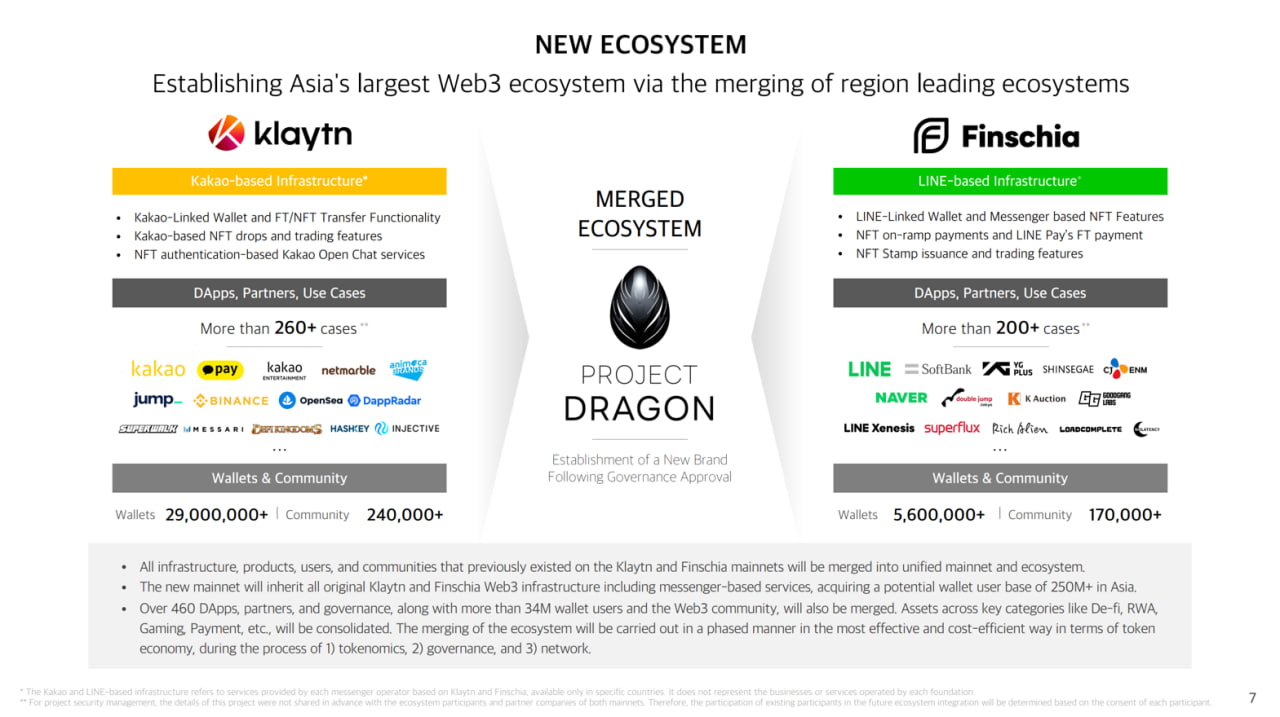
The Chairman of Kaia Foundation is Sam Seo, who has been deeply familiar with Bitcoin and blockchain since 2017 and holds a PhD in high performance computing. Previously, Sam served as CKO at KrustUniverse, leading the development and operation of Klaytn. In addition, he served as CTO at GroundX (Kakao's blockchain subsidiary) and as an assistant computer scientist at Argonne National Laboratory.
The joint support of the two giants, Kakao and LINE, has undoubtedly injected strong momentum into Kaia's development. Kakao's usage rate in South Korea is as high as 96%, and it also has a significant impact in Vietnam. LINE is deeply loved by users in Japan, Taiwan, Thailand and other regions. Adding the two together, Kaia's potential user base exceeds 250 million, significantly improving its global coverage. With such a large user base, Kaia is expected to greatly increase the popularity and acceptance of blockchain technology in the East Asian market, lay a solid foundation for the large-scale application of blockchain technology, and then create a large-scale and vibrant Asian largest Web3 ecosystem. Other investors in Kaia include Hashed, IDG Capital, etc.
1.1.2 Important time points
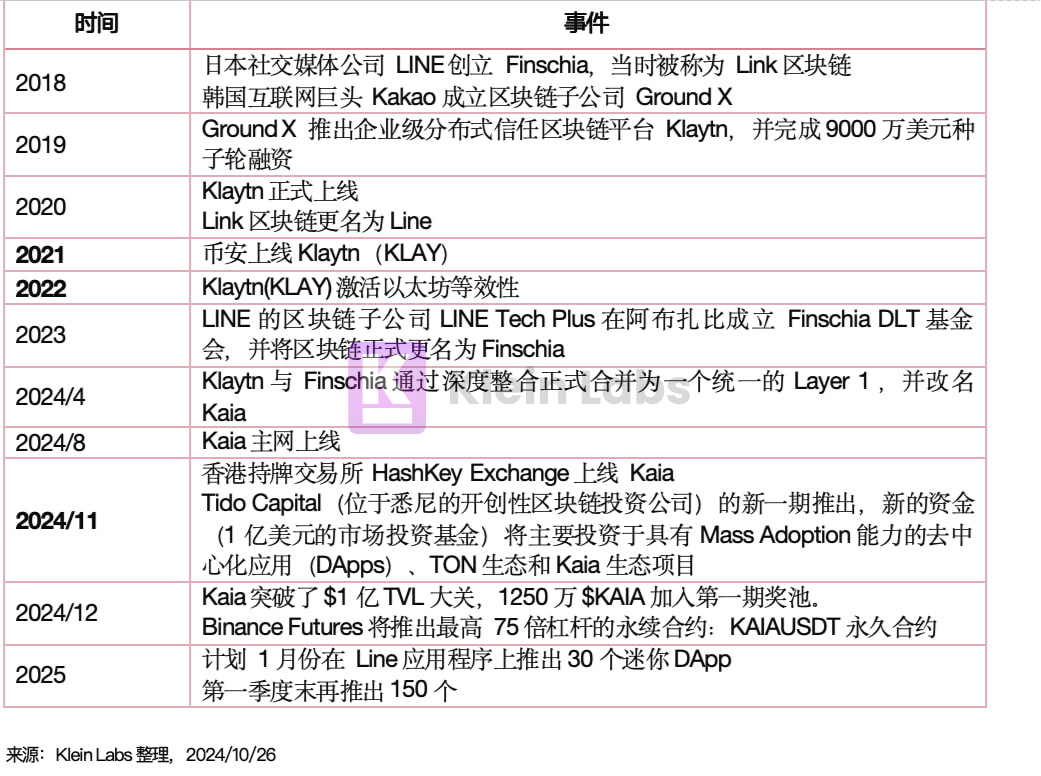
Let’s take a closer look at Kakao and LINE.
1.1.3 Kakao and Klaytn
Kakao Talk is one of the most popular instant messaging apps in South Korea, with nearly 49 million monthly active users in Q3 2024, 90% of which are from South Korea. The company has more than 17k employees and reported an operating profit of 130.5 billion won (93.48 million U.S. dollars) in Q3 2024, a year-on-year increase of 5%. Among them, the platform department, including Kakao Talk, achieved growth, with revenue increasing by 7% to 943.5 billion won (707.63 million U.S. dollars).
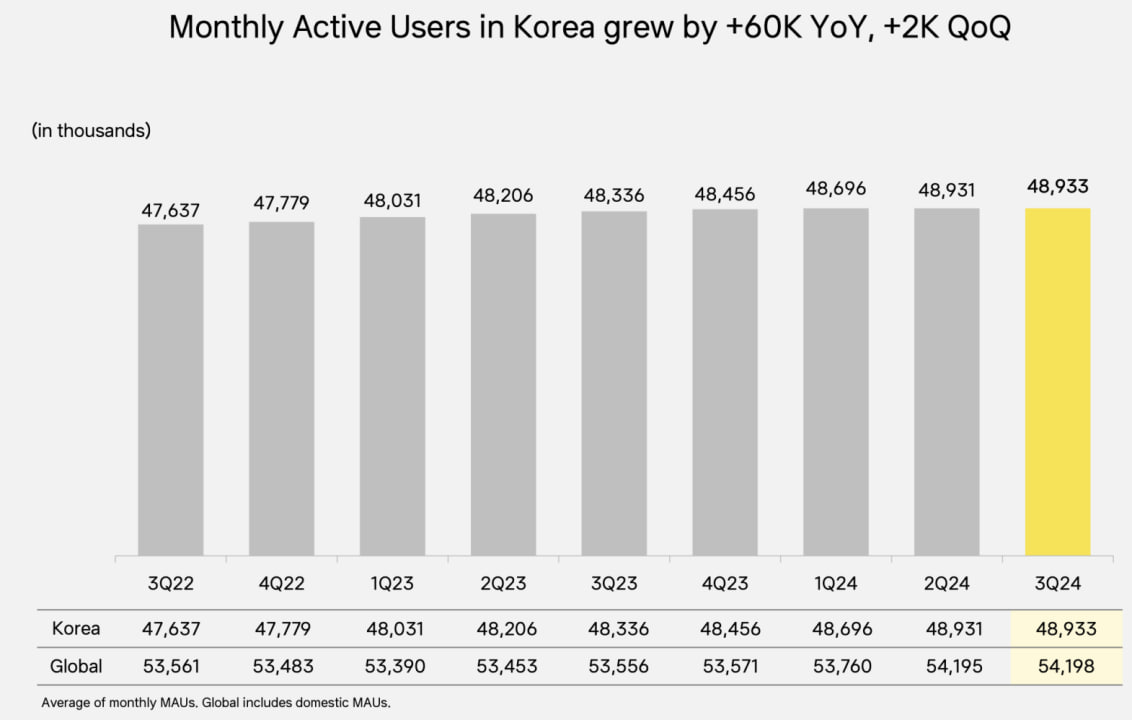
Klaytn was built for DApp developers and enterprises from the beginning. The ecosystem enables developers to unleash their creativity and expand user experience. This provides a strong technical foundation for Kaia. Klaytn has a cumulative transaction volume of 376 billion US dollars, more than 29 million Web3 wallet users, more than 240k community members, and an ATH Onchain TVL of more than 1 billion US dollars. In addition, it has a strong influence in Singapore and Vietnam.
The Korean market is already crypto-friendly, and its local exchange Upbit has become a leading exchange in the crypto industry, and Web3 projects are proud to be able to log in to Upbit. Against the backdrop of Korean users speculating in cryptocurrencies, Kaia's ceiling will undoubtedly give us endless reverie.
1.1.4 Line and Finschia
As the most popular communication platform in Japan, LINE covers 70% of the Japanese population and also dominates markets such as Thailand and Taiwan. Among them, Japan has 92 million monthly active users, while the number of users in Thailand has exceeded 51 million (it is the most popular social platform in Thailand), Taiwan has 21 million users, and the Indonesian market also has 13 million users. This high user penetration provides a solid foundation for its advertising, payment and content services. For example, Nielsen's LINE usage behavior survey in 2024 showed that the proportion of Taiwanese people aged 15-65 using LINE in the past seven days was as high as 92.1%, of which nearly half of the users were medium and heavy users, and they checked LINE messages 14 times a day on average.
Compared with other social platforms, LINE's unique ecological integration capabilities are particularly prominent. Users can consume its rich content products on LINE, including more than 300,000 comic books and 9 games that integrate social interactions. This diversified function gives LINE a significant advantage in maintaining user activity. In addition, the average usage time of more than 4 hours per week also highlights its irreplaceable role in users' daily lives.
This comprehensive ecosystem provides Kaia with a unique strategic advantage. LINE's users are highly concentrated and active, and the integration of its advertising and payment functions allows brands and services to accurately reach the target population. In addition, the regionalization strategy of the LINE ecosystem ensures that its platform content is closely matched with the cultural needs of users, which will create an efficient path for Kaia's localized promotion.
LINE's payment ecosystem also demonstrates its potential in the blockchain economy. With 40 million monthly active payment users and over $12 billion in annual transaction volume, LINE Pay has provided its users with a seamless digital payment experience. This payment infrastructure, coupled with its highly sophisticated advertising capabilities (reaching over 200 million users per month), provides a natural advantage for the implementation and expansion of blockchain projects in the Asia-Pacific market.
Of particular note is the LINE Miniapp project, a bridge between Web2 and Web3. This feature not only allows existing users to easily access decentralized applications, but also builds a highly compatible development environment by deeply integrating its payment, advertising, and communication ecosystems.
LINE's blockchain Finschia was launched as early as 2018. After about 5 years of development, it has more than 5.6 million Web 3 wallet users, 170k+ community members, and occupies an important position in Japan, Taiwan, Thailand and Abu Dhabi.
LINE's strategic direction shows that in the future Web3 world, it will not only be a participant, but also a promoter and accelerator, helping the entire industry cross the critical gap from technology to mainstream application.
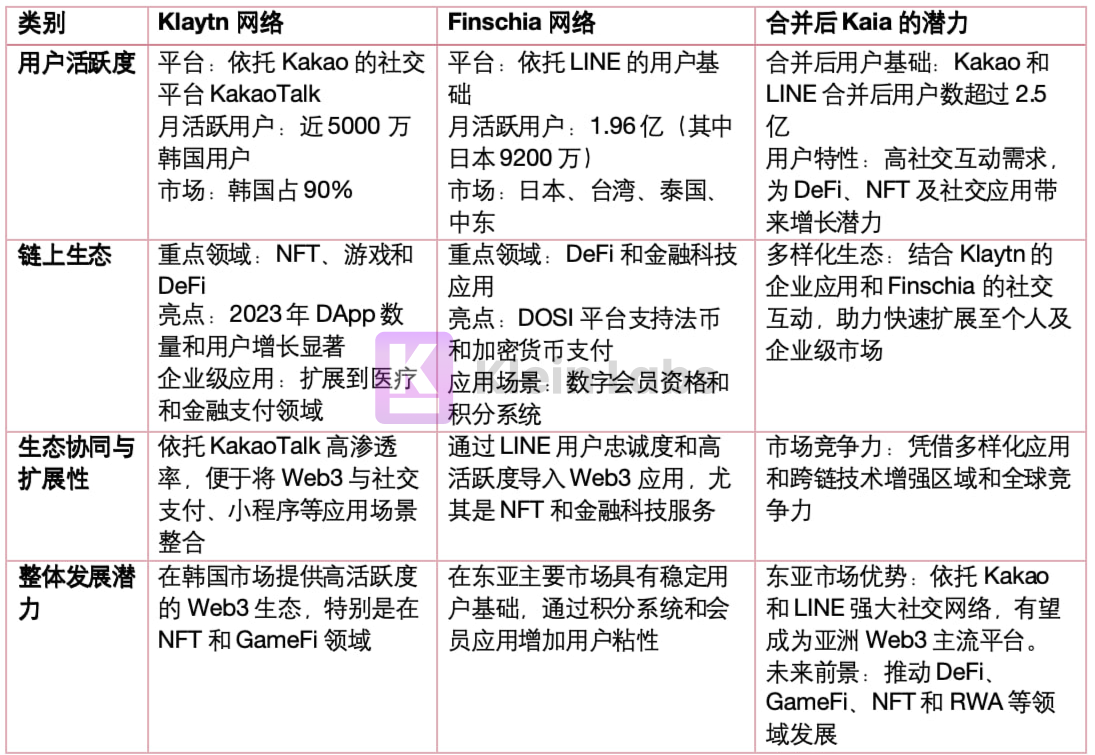
Currently, Kaia has confirmed that it will launch the SDK of Line Mini Program, and will launch the first batch of Line Mini Program applications in January 2025, while meeting regulatory needs. On the Kakao side, of the six council members of Kaia, three are from Kakao's blockchain Klaytn. In addition, Kakao and its affiliates hold approximately 9.8% of Kaia's total supply and actively participate in its governance. However, regulatory uncertainty in South Korea currently prevents Kakao from playing a more active role in blockchain initiatives, such as launching mini dApps like LINE. However, once these regulatory uncertainties are resolved and LINE's mini dApp service is successful, Kakao is expected to fully embrace blockchain integration.
1.2 Token Economics
1.2.1 Token $Kaia
Kaia's native token KAIA plays a core role in the blockchain economy and is used to pay transaction fees when creating or executing smart contracts or transferring KAIA. It is not only a means of payment for transactions, but also provides power for the normal operation of the entire system:
- Incentive mechanism: Platform customers incentivize consensus nodes (CNs) by paying KAIA, as these nodes are responsible for verifying transactions and executing smart contracts. Simply put, nodes provide computing power and resources, and users pay KAIA in return, which is a mutually beneficial relationship.
- Promote development quality: The fees paid with KAIA are proportional to the complexity and resource consumption of the smart contract. If the developer's code is too inefficient or redundant, it will be more expensive to execute the code. This mechanism encourages developers to optimize code quality and avoid wasting computing resources.
- Maintaining network health: CN nodes consume computing power and bandwidth to support network operations. Rewards from KAIA can motivate more nodes to participate in the consensus process, thereby ensuring the decentralization and stability of the network.
Each new block will automatically issue KAIA tokens, with an initial annual inflation rate of 5.2%. The block reward distribution is as follows:
- CCO and community: 50% (20% block creator rewards, 80% staking rewards)
- KEF (Kaia Ecosystem Fund): 25%
- KIF (Kaia Infrastructure Fund): 25%
This distribution model both incentivizes network participation and supports the growth and development of the Kaia ecosystem.
The on-chain governance system implemented by Kaia is designed to be fair and inclusive:
- Voting rights are proportional to the number of KAIA tokens staked.
- Caps on voting rights prevent the suppression of minority opinions.
- Allow delegation of voting rights.
- All governance proposals are recorded on-chain to ensure transparency.
From the perspective of the coin price, Kaia's performance is also very impressive. Since Klay was renamed Kaia and listed on Binance, it has been rising all the way.
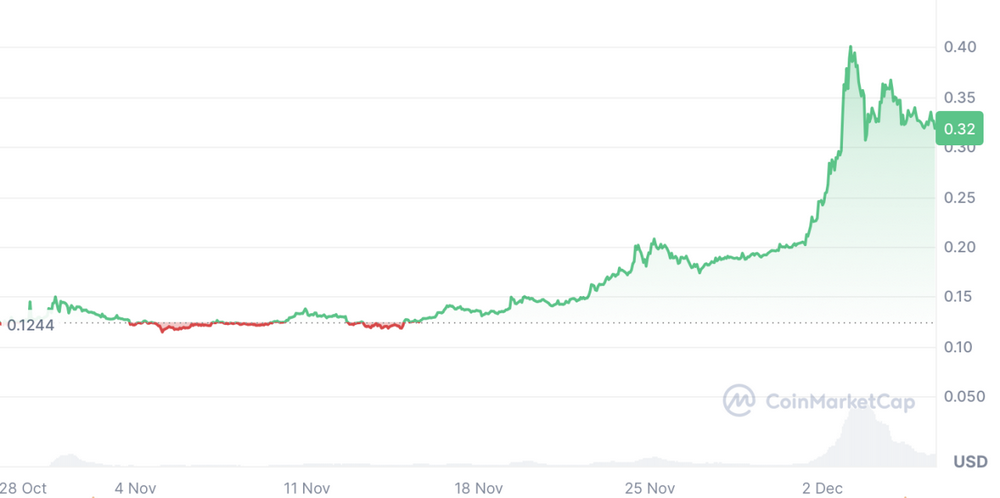
1.2.2 Governance Council
As technological advances drive the rapid growth of the Metaverse, decentralized autonomous organizations (DAOs) and developers are becoming important forces in the new economic form. Kaia follows this trend and launched the Kaia Governance Council (GC), which consists of 31 trusted early members, most of which are top institutions. Including: Kakao, Binance, Google Cloud, GS HomeShopping (the number one multimedia retailer in South Korea), LG Uplus (affiliated with LG Corporation, the largest enterprise in South Korea), Hanwha Systems (the second largest non-bank financial group in South Korea), Everrich Group (a real estate developer with main business in South Korea, Taiwan and Southeast Asia), HashKey (a leading fintech group headquartered in Hong Kong, focusing on the development of blockchain), NEOPLY (a leading startup accelerator under NEOWIZ, a large Korean online gaming company specializing in blockchain investment), etc.

Through this choice, the Kaia platform successfully achieved stable operation of the mainnet to ensure rapid and efficient advancement of technology stability and operational implementation in the early stages of platform development, laying a solid foundation for subsequent innovations in governance models.
Not only that, Kaia also expands GC membership from traditional enterprises to DAOs and builders to adapt to the needs of the new era. Kaia's ultimate vision is to become a fully decentralized "DAO of DAOs" that unifies the voices of all governance entities through on-chain mechanisms. This is not only a technological innovation, but also represents a real change in governance structure - giving all stakeholders a greater voice and setting a new benchmark for the decentralized development of the metaverse.

Kaia's governance framework is not only the core pillar of its platform development, but also a key highlight in attracting global developers, communities and organizations to participate. Through a forward-looking and flexible governance mechanism, Kaia is laying a solid foundation for the sustainable growth of the blockchain ecosystem.
Kaia also works closely with government agencies, for example, the Bank of Korea has chosen its parent company Ground X as the main technology provider for the blockchain-based digital won simulation.
1.3 Technical Architecture Principles
Kaia is a highly optimized, BFT-based public blockchain designed to meet enterprise-grade reliability and performance standards.
Kaia Blockchain provides:
- 1 second block generation and confirmation time.
- It can process 4,000 transactions per second.
- Low gas price, about 1/10 of Ethereum.
- Compatible with EVM and supports Solidity contracts.
- Governance is carried out by the Kaia Governance Committee, which is composed of world-renowned companies.
Kaia's network structure is divided into three logical sub-networks:
- Core Cell Network (CCN): Consists of core cells (CC) responsible for transaction verification, execution, and block creation.
- Endpoint Node Network (ENN): Consists of endpoint nodes (EN), responsible for processing RPC API (remote procedure call) requests and service chain data.
- Service Chain Network (SCN): An auxiliary blockchain independently run by DApp, connected to the main chain through EN.
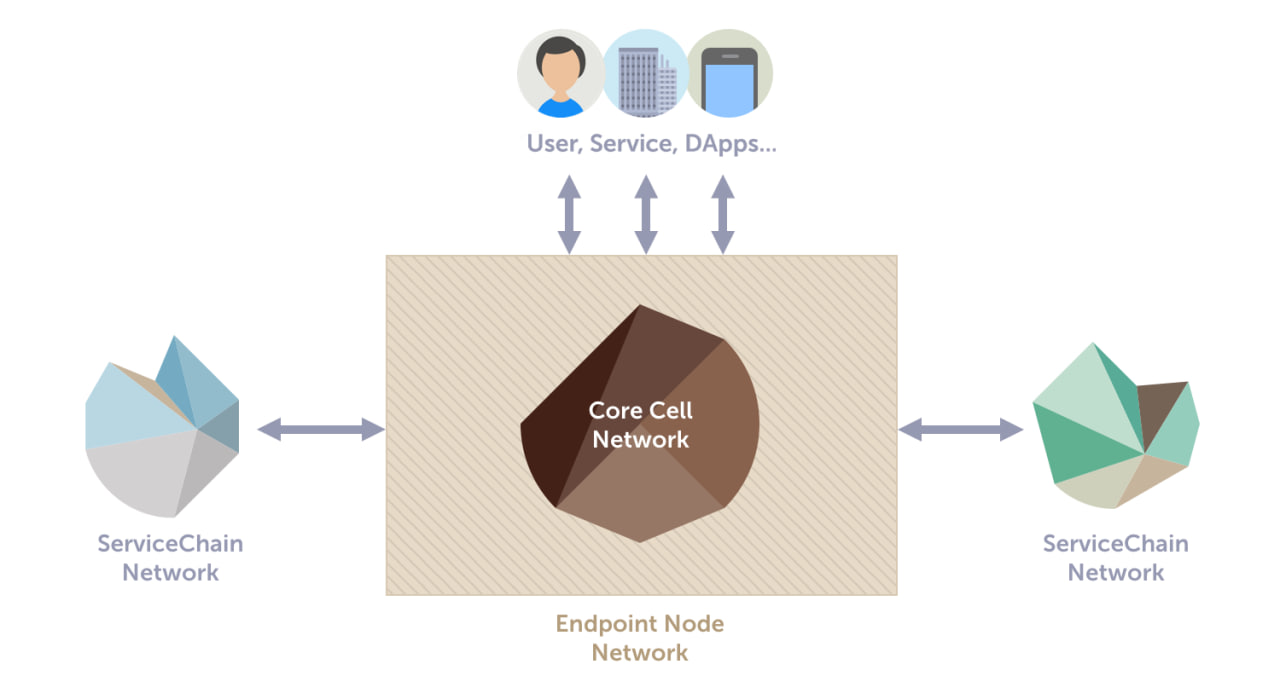
These mechanisms make Kaia blockchain a platform with high performance, security and compatibility, especially suitable for application scenarios that require fast transaction processing, compatibility with the Ethereum ecosystem, and cross-chain interaction requirements. Its design can not only meet the convenience needs of developers, but also support the user experience in high-frequency trading scenarios. At the same time, through multiple security measures, it ensures the reliability and anti-attack capabilities of the system. Specifically, it is reflected in the following five aspects.
1.3.1 Consensus Algorithm
A consensus algorithm is a mechanism used to reach agreement among a group of participants who do not trust each other. Its core goal is to determine which blocks are "valid" in a blockchain network and ensure the stability and reliability of the entire system. In blockchain technology, the performance of the consensus algorithm directly affects the efficiency of the network and plays a vital role in the user experience of blockchain applications. For example: the more efficient the consensus algorithm, the faster the blockchain can process transactions.
PBFT (Practical Byzantine Fault Tolerance) is a special consensus algorithm that allows nodes to communicate with each other to directly confirm the validity of blocks, thereby avoiding fork problems. However, PBFT also has limitations. As the number of participating nodes increases, the amount of communication between nodes increases exponentially. Therefore, PBFT is suitable for networks with a limited number of nodes.
Kaia uses an optimized version of Istanbul BFT to solve the communication bottleneck problem of PBFT and achieve high performance. In Kaia, there are three types of nodes: CN (consensus node), PN (proxy node) and EN (endpoint node).
- Consensus Node (CN): responsible for generating blocks and managed by the Core Node Operator (CCO).
- Proxy Nodes (PN): Transfer data between consensus nodes and users. Provide network interface, transmit transaction requests and propagate blocks.
- Core Unit (CC): Consists of one consensus node (CN) and two proxy nodes (PN).
- Endpoint (EN): Acts as a network endpoint, handles API requests and data processing, connects users and the network, and provides access services.
- Bootnode: A special node operated by Kaia that helps new nodes join the network.
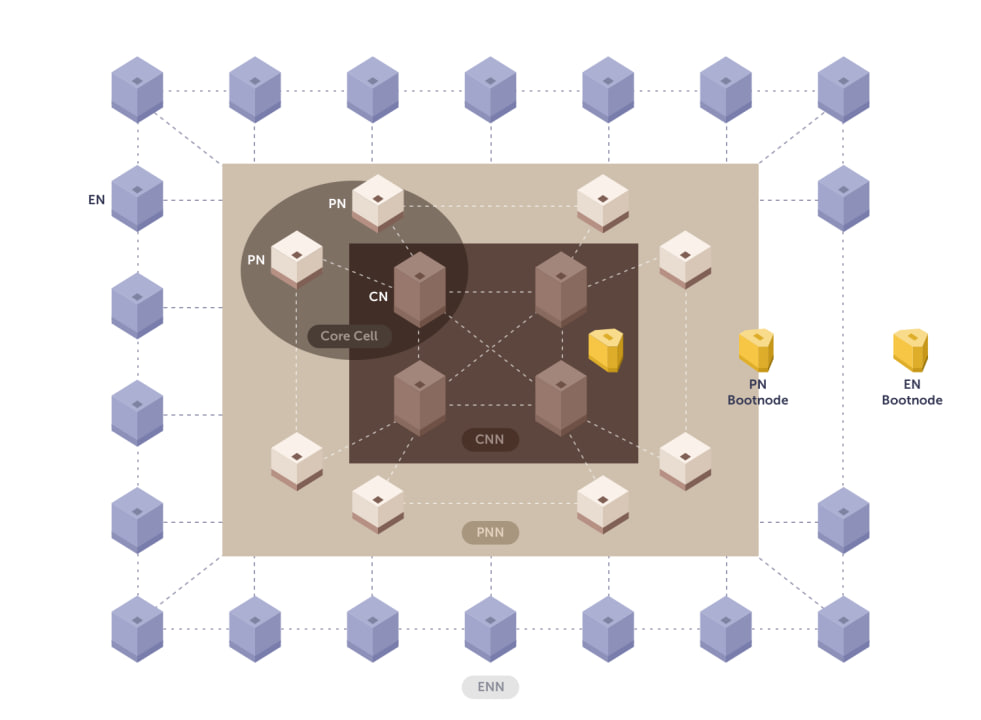
Since validation and consensus are performed for each block, there will be no forks, and once consensus is reached, the finality of the block is guaranteed immediately.
In addition, the problem of increased communication volume in the BFT algorithm is also solved by utilizing a randomly selected committee. CNs collectively form a committee, and when each block is generated, a part of them is selected as committee members using VRF (Verifiable Random Function). The main process is:
- Randomly select the committee: A mathematical method (called VRF, verifiable random function) is used to fairly and randomly select a group of people who are responsible for generating and verifying blocks. This group of people is called the "committee", which includes "proposers" (responsible for proposing new blocks) and "verifiers" (responsible for checking whether the blocks are compliant). The role of VRF is to ensure the fairness of the election while ensuring that the entire process is verifiable but unpredictable, which makes it difficult for malicious nodes to attack.
- Generate a block: The selected proposer will generate a new block. The block contains the transaction data that needs to be processed.
- Verification and Signature: The validators in the committee will review whether the block submitted by the proposer is correct. If more than two-thirds of the validators approve and sign, the block will be added to the blockchain.
Since consensus information is only exchanged between committee members, the communication volume will not exceed the designed level even if the total number of CNs increases.
1.3.2 Block Generation and Propagation
Kaia's block generation and propagation design is simple and efficient, ensuring the stability and scalability of the system. The specific features are as follows:
- Rapid block generation: The goal of each round of operations is to generate a block within 1 second, which is a highly efficient design in the blockchain field.
- Random but deterministic election process: Although the election of proposers and committee members is random, the process is determined by the algorithm and all nodes can verify this randomness. This design increases security and ensures fairness.
- Two-thirds signature rule: A new block can only be added to the blockchain after more than two-thirds of the committee members sign and agree. This mechanism ensures the credibility and immutability of the block.
- Multichannel Propagation: In order to avoid network congestion, Kaia adopts the method of independent propagation of blocks and transactions, which is similar to transmitting different information on different lanes. Blocks and transactions are propagated through independent channels, which greatly reduces delays and conflicts.
1.3.3Kaia Virtual Machine (KVM)
Kaia's virtual machine (KVM) is the core component for running smart contracts. Its design concept is compatibility and scalability. Its main features include:
1. Based on Ethereum Virtual Machine (EVM):
Kaia directly inherits the architecture of the Ethereum virtual machine, so all Ethereum smart contracts can run seamlessly on Kaia.
2. Extended functions:
In addition to supporting Ethereum opcodes (smart contract execution instructions), Kaia adds some specialized precompiled contracts. These contracts are optimized code modules that can improve the efficiency of specific operations.
3. Compatible with Ethereum development tools:
Developers can use popular Ethereum development tools such as Remix, Hardhat, Foundry, etc., with almost no need to learn new tools.
4. Easy Migration:
If developers have already developed smart contracts on Ethereum, they can deploy the contracts to the Kaia platform with minimal modifications, which reduces development costs and migration risks.
This makes Kaia an extension of the Ethereum ecosystem, able to better capture the vast number of EVM developers.
1.3.4 Security Measures
Kaia's virtual machine (KVM) is the core component for running smart contracts. Its design concept is compatibility and scalability. Its main features include:
Kaia has adopted a series of designs to improve the security of the system:
1. Randomly select the proposer:
VRF (Verifiable Random Function) is used to randomly select the proposer of the block. This makes it impossible for attackers to predict who will be the proposer in the next round, thereby increasing security.
2. Key separation:
Validators use two different keys:
- Verification key: used to participate in block verification.
- Reward Key: Used to claim rewards.
This design can effectively prevent hackers from gaining both verification permissions and rewards after attacking a certain key.
3. Transparent verification process:
Each member of the committee must verify the new block, and all signature records are public, and anyone can check the verification results.
These measures ensure that the Kaia system remains secure and stable when facing hackers or malicious nodes.
1.3.5 Interoperability
One of Kaia’s design goals is to achieve seamless interaction with other blockchains, specifically:
1.EVM compatibility: Kaia supports Ethereum’s smart contract language (Solidity), and developers can easily migrate applications on Ethereum to Kaia.
2. Cross-chain capability: Kaia can interact with other EVM-SDK-based blockchains to achieve cross-platform transactions and smart contract execution. Currently, cross-chain bridges such as Butter Network supported by Map Protocol have been connected to Kaia's cross-chain.
3. Support multi-chain ecology: Not limited to Ethereum, Kaia has also designed a mechanism that can collaborate with other blockchain systems.
This makes Kaia a flexible blockchain platform that can meet the needs of various cross-chain scenarios, such as cross-chain asset transfers of decentralized exchanges (DEXs), cross-chain smart contract calls, etc.
1.4 Competitors
Since both started from social media and led from Web2 to Web3, here we will focus on comparing Kaia and TON based on Telegram.
Telegram, which has more than 900 million users, offers games including Catizen and Hamster Kombat through the Telegram Open Network (TON) blockchain and has pioneered the delivery of web3 over social media.
The story of TON can be traced back to 2017, when it was proposed by Telegram founders Pavel Durov and Nikolai Durov. The original intention of the project was to deeply combine blockchain technology with Telegram's social ecology to create an ideal platform for decentralized applications (DApps), while meeting the needs of high-speed and secure transactions. In 2018, Telegram raised $1.7 billion for the TON project through private placement. However, in 2019, the U.S. Securities and Exchange Commission (SEC) filed a lawsuit against Telegram, accusing it of issuing Gram tokens as unregistered securities. This legal turmoil eventually led to Telegram announcing the abandonment of the TON project in 2020.
Despite Telegram's withdrawal, TON's open source community did not stop, but continued the project's vision and renamed it The Open Network (TON). In 2021, the TON mainnet was officially launched, marking the birth of a new decentralized ecosystem focused on efficient and scalable blockchain infrastructure.
TON is designed with high performance and strong scalability as the core, using sharding technology and Proof-of-Stake (PoS) consensus mechanism to support large-scale parallel transaction processing. In addition, TON provides a series of innovative features, including:
- TON DNS: Provides an easy-to-remember address naming system for users and applications, reducing the complexity of blockchain interactions.
- TON Storage: A decentralized storage solution that meets file security and data storage needs.
- Instant Payment Channel: Provides an extremely low-latency payment network for high-frequency trading users.
These technical features not only provide convenience for TON developers and users, but also lay the foundation for the richness of its ecosystem.
As of 2024, TON has attracted more than 800 applications to go online, including stablecoin solutions, NFT platforms, and decentralized finance (DeFi) applications. Especially in the field of stablecoins, the supply of USDT on the chain has grown rapidly, injecting strong liquidity into its ecosystem. Among them, the more representative ones include:
- Tap to Earn mini-games: TON chain’s most representative chain games, such as Notcoin and Hamster Kombat, have attracted a large number of users, with the number of daily active users exceeding 5 million. This type of game is characterized by “low learning cost and high ease of use”, which is very suitable for fragmented time play and has strong appeal in the TON chain ecosystem.
- Decentralized Finance (DeFi): The TVL (total locked value) on the TON chain has grown significantly, and the current locked value has exceeded US$600 million, making it one of the main competitors in the DeFi field.
- NFT and SocialFi applications: The TON chain is based on Telegram's traffic entrance. Through application scenarios such as NFT and SocialFi, it has deepened the concept of Web3 into the social field, forming an ecological application system that is both entertaining and interactive.
In addition, TON has successfully attracted a large number of developers and decentralization enthusiasts with its global community base and good technical performance.
However, TON has also experienced challenges, such as brief infrastructure outages in the face of high network activity. This reflects that the project needs further optimization in terms of development potential and technical stability. The main comparisons are as follows:

1.5 Preliminary Value Assessment
Although TON still maintains global influence in decentralization and technological innovation, KAIA's localization strategy and strong user base make it an irreplaceable position in the Asian market. KAIA is not only an important player in the East Asian blockchain ecosystem, but is also likely to become a key force in promoting the popularization of Web3 applications in the future.
We compared the following indicators. Among them, from the perspective of MC/TVL indicators, KAIA's current valuation is significantly lower than TON, suggesting that its market positioning and localization strategy have not been fully quantified, and its capital market potential has not been fully tapped, especially the social and payment dividends released by its huge user ecosystem based on LINE and KakaoTalk have not been fully converted into capital market value. The MC/TVL ratio of TON shows that the market highly recognizes its technical capabilities and vision of global expansion, but the high valuation may mean that its growth space is gradually narrowing.
In addition, KAIA's current valuation may not fully reflect its strategic significance in the implementation of Web3 applications. For example, through deep integration with the existing social payment system, KAIA has achieved seamless connection between innovative scenarios such as DeFi and NFT and users' daily behaviors. This endogenous growth model provides natural stickiness and vitality for its ecological development.
However, whether this potential can be truly realized still needs to wait for the implementation of specific application scenarios. In particular, the LINE mini app, which is scheduled to be launched in Q1 2025, will be an important step for KAIA to expand its influence in Web3 and will become an important opportunity to test its ecological value. This milestone is not only related to whether KAIA can fully unleash its ecological potential, but also will further verify whether it can surpass other competitors in the East Asian market and become an irreplaceable blockchain solution provider.
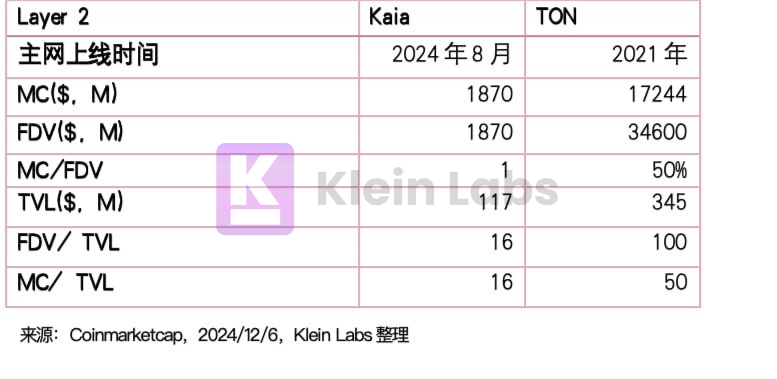
2. Kaia’s Ecosystem
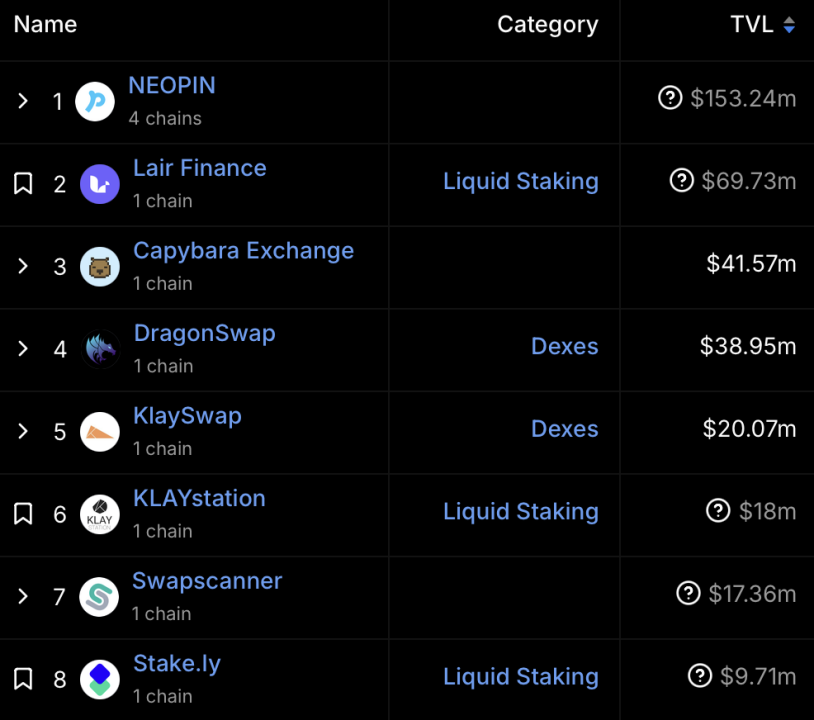
2.1DEFI Track
In the real world, economic activities often rely first on social infrastructure (such as national infrastructure) and natural infrastructure (such as the natural environment). On this basis, financial infrastructure maximizes the efficiency and influence of economic activities by providing services such as capital lending, and becomes a catalyst for economic development.
However, the development path of the blockchain world is completely different from the real world. Recognized leading blockchain networks such as Ethereum, Arbitrum, Optimism, BNB and Solana all first built the DeFi ecosystem of financial infrastructure, and then gradually promoted the implementation of DApps (decentralized applications) in other industries. Through functions such as capital lending, token exchange and reward mechanism design, DeFi provides the necessary liquidity support for various DApps, enabling them to establish a foundation on the chain. In other words, in the blockchain world, the financial infrastructure of the network has become a prerequisite and an indispensable foundation for the accumulation of digital products and the development of the ecosystem.
This DeFi-driven vision is helping Kaia become an important infrastructure for the next generation of blockchain networks. To this end, Kaia launched the D2I (DeFi to Infrastructure) program.
In the DeFi summer of 2021, Kaia attracted a lot of funds through liquidity mining. However, the bursting of the on-chain economic bubble in 2022 caused the ecological scale to shrink significantly, and Kaia's competitiveness was also affected to a certain extent. The D2I program aims to quickly revitalize this underutilized ecosystem through incentives and provide financial infrastructure support for new DApps after the chain merger. In the long run, the core goal of the program is to comprehensively reshape Kaia's DeFi ecosystem and help it rise again.
In the first half of 2024, Kaia selected three DEX partners through the D2I program: two v3 AMM (spot)-based DEXs, Dragonswap and Kaiaswap, and one coverage AMM (spot)-based DEX, CapyBara. Although Kaiaswap recently withdrew from the ecosystem, Dragonswap and CapyBara have maintained an active pace of construction. So far, these teams have achieved the following results:
- Cumulative transaction volume: more than US$710 million;
- Total locked value (TVL): more than 39 million US dollars;
- Number of transactions: more than 3.1 million completed;
- User growth: Cumulative users exceed 260,000;
- Ecological contribution: 245,000 KAIA were destroyed.
It is worth noting that the $KAIA transaction volume of the on-chain DEX is already comparable to that of Binance, indicating that Kaia's DeFi ecosystem is gradually recovering.
With the two spot DEX teams selected through the D2I program in the first half of 2024, Kaia plans to bring in Avalon Finance and, if necessary, a DEX anchor team that can handle institutional liquidity. The DeFi ecosystem is evolving, transforming from complex "funding building blocks" such as yield aggregators and leveraged liquidity mining to derivatives based on ecosystem native tokens and stablecoins. This change is consistent with growing institutional demand. As the core financial infrastructure (spot DEX and money markets) gradually stabilizes, Kaia will focus on developing derivatives based on native coins and stablecoins (such as LSDfi, LRTfi, and yield stripping derivatives). Its primary goal is to increase the market share of LSD and LRT, so that Kaia's native currency plays a more active role in the DeFi ecosystem.
The D2I program demonstrates Kaia's strategic foresight in the revitalization of the DeFi market. Through precise incentive mechanisms and collaboration with strong ecological partners, Kaia not only solves current core problems, but also lays a solid foundation for future development. With the gradual improvement of core financial infrastructure and derivatives markets, Kaia is expected to stand out in the increasingly fierce blockchain competition and become a trusted DeFi solution provider for enterprises and users.
In the future, D2I builders will develop from simple DEX platforms to comprehensive platforms. They are also constantly adding new features, such as Launchpads, Meme platforms, liquidity managers, lottery and perpetual futures. Now these powerful infrastructures allow all DApps in the Kaia ecosystem, including the upcoming Mini DApp on Line, to easily build an on-chain ecosystem through these features.
2.1.1 Neopin
Project Overview: Founded in 2021, NEOPIN is a "licensed DeFi protocol" under the Korean gaming giant Neowiz, which has the advantages of both CeFi and DeFi. It is the first Defi in the Kaia ecosystem. It is committed to building a bridge between traditional finance and DeFi protocols for users within a compliance framework. NEOPIN has been selected for the innovation program of the Abu Dhabi Investment Office and is working with local government agencies to develop a DeFi regulatory framework. It is a very rare DeFi service provider with regulatory permission, and actively embraces regulation to ensure unrestricted long-term development. The current TVL has reached US$240 million, supports 59 tokens, and has 22 nodes.
X: @NeopinOfficial
2.1.2 Lair Finance
Project Overview: Lair Finance is a Kaia liquidity staking protocol that aims to provide users with decentralized finance (DeFi) income opportunities. Through its unique token economic model and staking mechanism, users can participate in liquidity provision and asset appreciation plans on the platform, obtain more KAIA token rewards, and achieve sustainable financial returns.
X: @LairFinance
2.1.3 CapybaraExchange
Project Overview: The first and largest DEX on the kaia chain. Features include ultra-high capital efficiency, transparency, and community priority. Its TVL has grown significantly in the past two months and has exceeded 40 million US dollars.
X: @CapybaraDEX
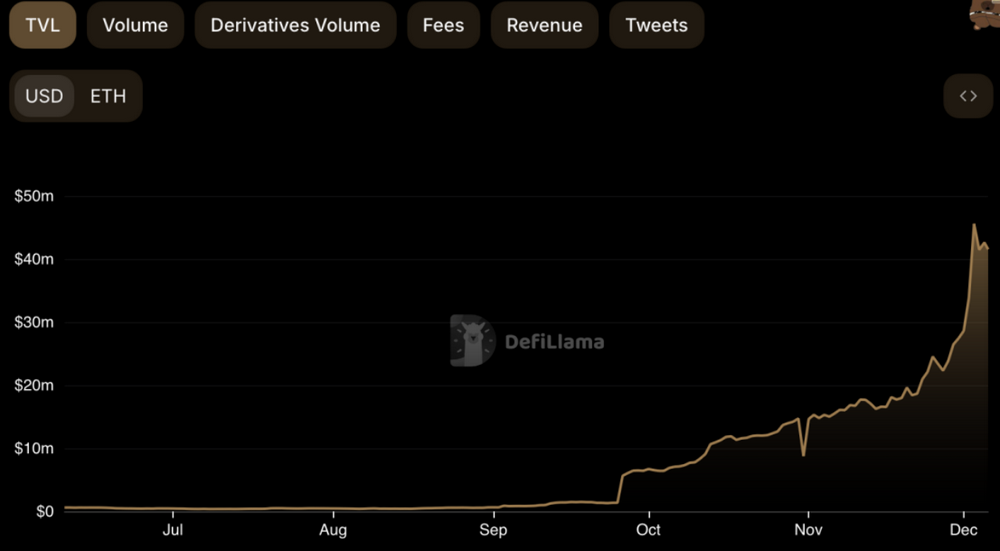
2.1.4 Avalon Labs
Project Overview: Avalon Labs (formerly Avalon Finance) is a leading Bitcoin-centric lending ecosystem, uniquely positioned at the intersection of DeFi, CeDeFi, and RWA (real world asset) lending. By connecting these three key areas, Avalon Labs has become a cornerstone of the rapidly growing decentralized finance sector. Avalon Labs chose to build its products on the Kaia chain, a decision based on a high degree of alignment between the two in core values. Kaia focuses on community-driven, sustainable development, and simplified user experience, which coincides with Avalon's vision in the field of decentralized finance (DeFi). Avalon Labs can bring its existing 80,000-90,000 active user base and significant total locked value (TVL) to the Kaia chain. Through this move, the influence of the Kaia chain will go beyond the Asia-Pacific region and penetrate into multiple market segments around the world, thereby expanding its influence in the international blockchain ecosystem.
X: @avalonfinance_
2.1.5 DragonSwap
Project Overview: DragonSwap is the central hub of DeFi on Sei, supporting AMM, prediction market and LST. DragonSwap is designed to be user-friendly and Sei community-oriented, and has now developed into the highest-performing parallelized liquidity center running on Sei V2. The current TVL has exceeded US$55 million, with nearly 120,000 users and an ATH of up to US$700 million. On March 8, 2024, DragonSwap was selected as a partner of the D2I program of the Kaia Foundation (formerly the Klaytn Foundation), and is committed to using the D2I liquidity incentive mechanism to promote the thriving development of the DeFi ecosystem on Klaytn.
X: @dragonswap_dex
2.2 Payment track
2.2.1 Alchemy Pay
Project Overview: Founded in Singapore in 2018, Alchemy Pay is a payment gateway that seamlessly connects cryptocurrencies and global fiat currencies for businesses, developers, and users. The Alchemy Pay Ramp solution can be integrated with platforms and DApps via plugins or APIs, providing an easy transition from fiat currency to cryptocurrency. Alchemy Pay supports payments in 173 countries: Visa, Mastercard, Discover, Diners Club, Google Pay, Apple Pay, popular regional mobile wallets, and domestic transfers, with a focus on emerging markets. It can also remit money to users in more than 50 local fiat currencies. Just recently, Kaia reached a cooperation with Alchemy Pay to provide a zero-fee $KAIA bridge service, seamlessly purchasing $KAIA with local fiat currency through bank cards or mobile wallets, and enjoying ultimate convenience.
X: @AlchemyPay
2.3AI Track
2.3.1 FlareAI
Project Overview: FlareAI is the first AI-driven DApp launched on the Kaia blockchain. This marks the fusion of cutting-edge AI technology with Kaia's powerful blockchain infrastructure, setting a new standard for innovation in the decentralized ecosystem. FlareAI aims to revolutionize the way AI and blockchain technologies are integrated, solving key challenges in AI development such as data quality, efficiency, and privacy. By leveraging Kaia's ultra-low latency and high-speed infrastructure, FlareAI provides developers and users with an unprecedented experience in creating and interacting with AI-driven solutions.
X: @flareai_io
2.3.2 FDN
Project Overview: FDN is an AI face recognition network that uses the incentive characteristics of Web3 to better obtain facial data, thereby playing a role in AIGC generation of 3D character images, advertising and marketing, and other scenarios. At the same time, blockchain technology is used to protect the privacy of user data. FDN has entered the first phase of Kaia Wave and has entered the acceleration plan of Web3Labs and Kucoin.
X:@project_fdn
2.4MINI DAPPS on LINE
In the Web3 Game universe of 2024, Ton and Telegram have led a group of Mini Apps to create a new business model. Relying on Telegram's amazing 900 million users, Web3 Games have gained a huge number of users and interactions that we have never imagined. Recently, LINE also announced the first batch of Mini Dapps to be launched. We will introduce them below:
1. Bombie: A meme game released by Pluto Studio that allows players to shoot zombies and get airdrop rewards. It has attracted 7 million game users and $10 million in game revenue in 3 months. Bombie is the world's first game that spans the two major social platforms of Telegram and LINE. It is scheduled to be launched on LINE Dapp Portal in January 2025. Users will be able to enter, play and accumulate user rewards directly through LINE Messenger.
X: @Bombie_xyz
2. Bullet Storm: An innovative arcade shooter that combines social engagement and reward-driven gameplay, attracting millions of players around the world.
X: @_KultGames
3. Captain Tsubasa (Minttown): Developed by software company MintTown, this is a mini-game based on the legendary Japanese football anime IP Captain Tsubasa.
X: @TsubasaRVonTG
4. Contentverse (Wizzwood): The team that pioneered the integration of Web2 social platforms and Web3 games. Wizzwoods is a pixel-style farm placement game that combines cross-chain technology and SocialFi elements.
X: @Wizzwoods_game
5. Elderglade: Elderglade is an AI-driven fantasy world game developed by blockchain game developer W3Forge, whose mobile game was officially launched on Telegram on September 23. W3Forge is the studio behind zkRace (165x ATH), ranked in the top 20 global IDOs in 2021 by CoinMarketCap, and ranked in the top 5 on the DAO Maker launchpad.
X: @Elderglade
6. Frog Defense: Frog Defense Game. Debuting on Kaia Blockchain and LINE for the first time, Frog Pikeman, a popular TikTok game with 1.7 million followers, is introduced to the Web3 gaming space. As LINE’s first tower defense game, Frog Defense combines engaging gameplay with the viral appeal of memes, creating an exciting entry point for millions of users to explore the rewarding potential of blockchain games.
X: @FrogDefense
7. Futr: Prediction Market Platform. Where real-world outcomes meet social connections. Designed for collaboration, Futr enables users to predict events, be rewarded for accurate insights with Futr tokens, and participate through its active social media hub. Build friendships, form tribes, and win together in a creator-driven ecosystem that makes predictions fun, social, and rewarding.
X: @thefutr_
8. Gee: Built by a community startup studio to cultivate unique digital companions on the Kaia blockchain.
X:@dokyoworld
9. Goblin Master: Goblin Master enables brands to create their own immersive digital realms that engage audiences through engaging gameplay and unique rewarding experiences. It creates a game world full of magical quests and imagination.
X: @GoblinMasterTon
10. Goblin Tycoon: Developed exclusively for LINE Messenger by Digital Fire Studios, it is an idle casual game where players can grow their goblin empire, acquire powerful weapons, upgrade resources, and battle epic bosses in a fun and addictive adventure.
X: @GoblinTycoonZoH
11. Heroic Arena: Heroic Arena interprets ACG culture from a new perspective and creates LINE's first anime-style click battle game (loved by millions of players around the world). Players can not only unlock a collection of exquisite anime character NFTs, but also use and trade the studio's future Heroic IP derivatives. A series of ACG games centered on NFT assets + $HAT will be developed for LINE fans.
X: @heroicarenagame
12. KeitoKun: KeitoKun is a one-stop entertainment application platform on Kaia and LINE. KeitoKun places a high priority on community-driven growth and decentralized innovation, transforming entertainment into an immersive and rewarding journey for users. It will be launched on Kaia and LINE in January 2025.
X: @KeitoKunyarn
13. Midnight Survivors: The first gacharoguelike game on LINE powered by KaiaChain, blends intense survival gameplay with a rewarding gacha system, exclusive in-app rewards, and the opportunity for players to earn money through its innovative in-game airdrop experience.
X: @Survivors_gg
14. Shin Chan's Match Daily: Dive into a quirky world that blends match-3 puzzles and spot-the-difference challenges, featuring the iconic Crayon Shin-chan world. Built by a subsidiary of GGI, the world's leading blockchain game publishing platform and content community.
X:@MIXMARVELGAME
15. SuperWalk: A healthcare and wellness portal Dapp for non-crypto users that seamlessly integrates fitness habits and tangible rewards, with more than 300,000 users.
X: @SuperWalk_
16. Web3.0 Plants vs Zombies: Web3 Plants vs. Zombies combines an innovative merge-and-upgrade mechanic with classic tower defense gameplay. Players collect and deploy powerful cards, build strategic defenses, fight waves of enemies, and ultimately encounter epic bosses. With dynamic progression, challenging levels, and vivid visuals, the game offers modern gamers an engaging experience that redefines tower defense.
X: @TelgatherGames
17. TCOM (Astroboy): TcomArena is a top action-adventure game that combines classic action role-playing game (ARPG) elements with innovative gameplay. Players will play the legendary characters Astroboy and Astroboy and embark on a thrilling adventure. By defeating hordes of enemies, unlocking powerful skills and upgrading attributes, players will grow in constant challenges and are committed to building the world's largest Web3.0 IP open platform.
X:@ACG_WORLDS_
18. Twelve Goblins: is a merge puzzle game from the Web3 project "Wizardry BC Project", which utilizes Drecom's IP "Wizardry".
X: @TwelveGoblins
19. X-Hero: Developed by Digital Fire Studios, X-Hero is a variation on the tower defense game where players summon heroes, strategize their defenses, and battle against relentless waves of monsters in an action-packed and addictive gameplay.
X: @DigitalfireStu
20. Yuliverse: Yuliverse is a gamified social metadata platform that leverages location-based service technology to transform users’ lifestyles into crypto assets.
X: @TheYuliverse
2.5 Other ecological activities
2.5.1 Kaia Wave
In September this year, Kaia Wave was officially launched, a Web3 maker program jointly developed by Kaia Foundation and LINE NEXT, which provides Web3 builders with the opportunity to connect with more than 200 million LINE users. Kaia Wave will provide up to $10 million worth of KAIA tokens, marketing support, venture capital connections, and user experience improvement tools to help DApps promote throughout Asia.
Since the launch of the Kaia Wave program, 400 project teams have participated. The Kaia Foundation and the LINE NEXT team will prioritize projects that have the potential to leverage the LINE Mini DApp UX infrastructure.
The picture below shows the Wave event held in Thailand in November.
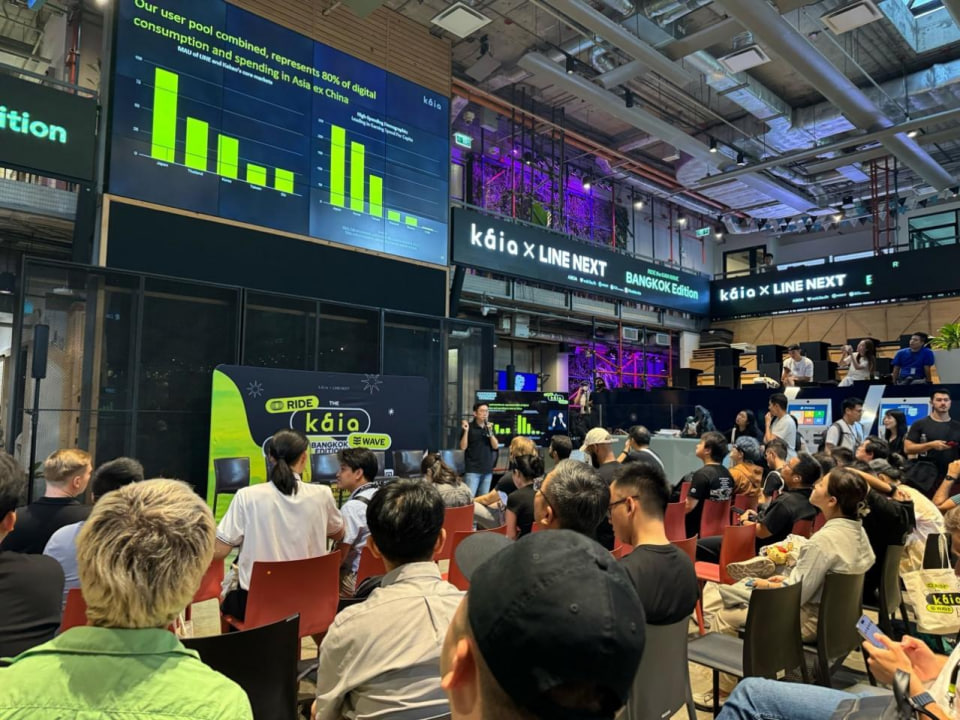
2.5.2 Line Next
Kaia also frequently co-hosts various offline events with LINE NEXT, such as the Kaia Demo Day project showcase event held just last month, Creator Alliance Assemble, etc. LINE NEXT is a dedicated Web3 enterprise under LINE, focusing on NFT business. In 2023, it received an investment of up to US$140 million from private equity fund operator Crescendo Equity Partners and its joint consortium.
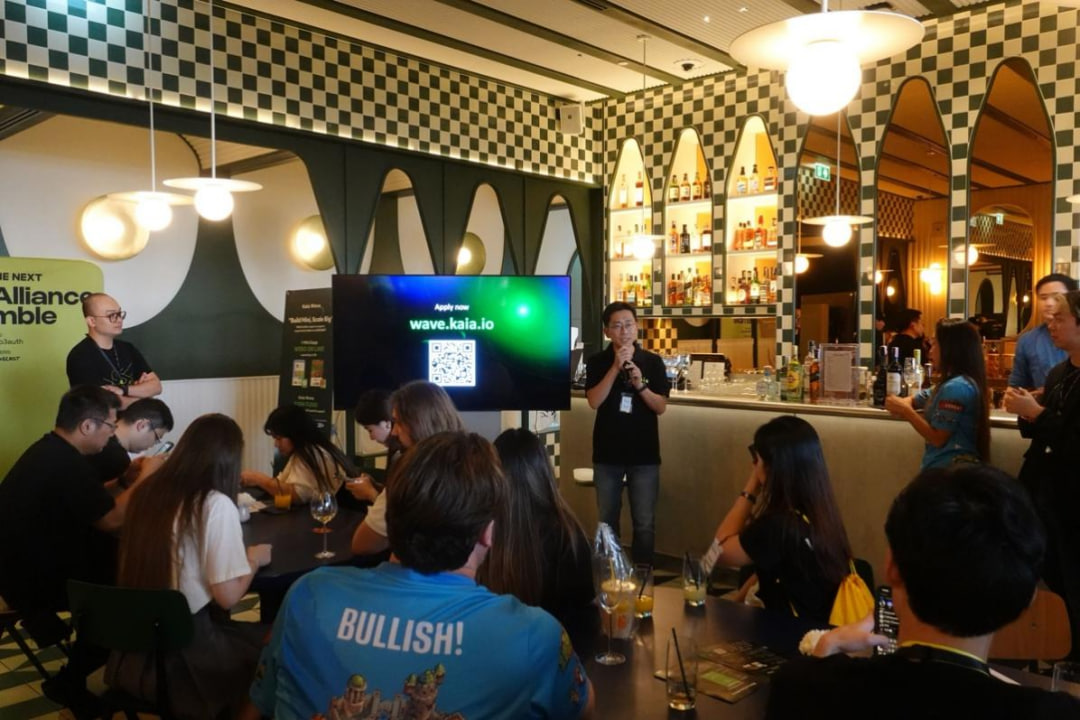
2.5.3 Kaia Grants
Kaia has launched multiple projects to provide a range of generous support and professional help for DApps. The following are some of the projects that have received Kaia Grant, including some well-known projects such as LayerZero, OpenSea, ELYSIA, etc.

Kaia Ecosystem Fund
KEF focuses on ecological construction, covering service rewards, developer community cultivation, infrastructure support, indirect investment, and the operation of the governance committee. The funds come from 25% of the total KAIA issued when the block is created. Its operation is transparent, and all budget and usage details must be approved by the governance committee and made public.
Kaia Infrastructure Fund
KIF focuses on supporting mainnet and infrastructure development, ecosystem acceleration (providing financial support to small Kaia blockchain ecosystem partners, attracting new GC members, and providing market liquidity, etc.) and foundation operations. It is also supported by 25% of the newly added KAIA, and ensures efficient and transparent execution of funds through strict internal control mechanisms.
Ignite on Kaia
The program aims to help achieve seamless developer onboarding by providing DApp developers with pragmatic market support in both technical and business aspects. The IOK program allows DApp developers to focus on product development, while industry experts are responsible for other important aspects such as wallets, marketing, security tools, API nodes, NFT markets, Oracles, development outsourcing, etc. In the program, especially for "Go-To-Market", the IOK fund can help projects pay for part of their marketing expenses.
3. Summary of highlights
In the global Web3 ecosystem, KAIA is like a rising star. Starting from the East Asian market, it has gradually built a set of blockchain solutions with regional advantages through precise positioning, technological innovation and ecological integration. Through the summary of the previous article, we have the following main points:
1. Unique positioning: Giants join forces to build the cornerstone of East Asian blockchain ecology
Kaia Chain was born out of the cooperation and support of two technology giants, Kakao and LINE, and is one of the most ambitious blockchain projects in the East Asian market. This alliance not only provides technical resources and capital backing, but also brings Kaia unattainable user potential. The user base of more than 250 million in total provides Kaia with a unique growth soil. This deep user base enables KAIA to naturally integrate blockchain services into social payment scenarios familiar to users and create a localized Web3 ecological experience. For users who are accustomed to Asian social culture, KAIA is not a strange technology platform, but an organic extension of their daily life.
2. Asset scale and ecological breadth: Asia's largest Web3 network
Kaia Chain unifies the two major networks of Klaytn and Finschia, with an asset size of over $75 billion, making it an unrivaled giant in the Asian blockchain field. More importantly, Kaia has built a rich ecosystem covering more than 360 DApps, covering a variety of fields such as decentralized finance (DeFi), NFT, games and social networking. This not only makes Kaia one of the largest Web3 ecosystems in East Asia, but also demonstrates its ability to build applications across multiple industries and its diversification potential.
3. Introducing a large number of existing Web2 users: a portal connecting Web and Web3
Kaia not only focuses on building a technologically advanced blockchain network, but also builds a low-threshold Web3 entrance for users by launching innovative products such as LINE MiniApp. The introduction of the "Kaia Wave" plan significantly lowers the entry barrier for users. This plan invests $10 million to support developers and attract large-scale ordinary users to the Web3 ecosystem through seamless Web2 touchpoints (such as Line Mini DApps). Kaia's mission is to transform "complex blockchain technology" into "one-click user experience" and make Web3 truly integrated into mainstream society.
4. Global Vision and Ecological Collaboration: From East Asia to the World
Kaia has fully utilized the strong position of Kakao and LINE in the Asian market and expanded its influence to the world, especially in the Middle East market. Its headquarters is located in Abu Dhabi, and its strategic location shows that it focuses on connecting the Asian, Middle Eastern, European and American markets. At the same time, Kaia actively cooperates with leading international DeFi projects and attracts top global blue-chip protocols (such as Avalon Labs) to join its ecosystem. This global and local layout strategy has made Kaia's global expansion solid and rapid.
5. Low valuation of MC/TVL
Compared with the higher ratio of TON, KAIA's valuation is significantly lower. This low valuation not only reflects the market's conservative judgment on its value positioning, but also implies KAIA's huge growth potential. Kaia's capital market value has not yet fully reflected its strong social and payment dividends, especially its strategic significance of deeply integrating into the user ecology in East Asia.
6. Planning for the future: Reshaping the digital infrastructure of finance and culture
Kaia's ambition is not limited to the technology itself, but also aims to change the way the entire digital economy operates. Its ecosystem is not just a collection of financial applications, but also reflects Kaia's grand vision of building a future digital society through culture, community and innovative technology. Kaia will continue to focus on the field of decentralized finance in the future, combining asset liquidity, on-chain governance and cross-chain interoperability to provide a stable core infrastructure for the global popularization of blockchain technology.
In our view, the story of Kaia Chain is not only a narrative of blockchain technology, but also an attempt at social change. It has demonstrated its outstanding ability to promote large-scale application of blockchain by deeply cultivating East Asia, integrating resources of giants and adopting a bold globalization strategy. In the future, whether Kaia can fulfill its mission of reshaping the global blockchain landscape will become an important indicator of the development of the blockchain industry.
4. References
1.https://www.kakaocorp.com/ir/referenceRoom/earningsAnnouncement?lang=en
2.https://www.techinasia.com/news/kakao-grows-profit-declining-sales
3.https://medium.com/kaiachain/kaia-d2i-program-report-7193c296db5a
4.https://medium.com/kaiachain/crafting-the-core-of-project-dragons-defi-ecosystem-caa72ec45211
5.https://www.digitalmarketingforasia.com/why-line-is-the-most-popular-social-media-app-in-japan/
6.https://docs.kaia.io/learn/governance/
7.https://usesignhouse.com/blog/line-stats/
8.https://www.aicoin.com/en/article/429056
9.https://www.coindesk.com/web3/2024/11/27/line-with-an-eye-on-telegrams-in-app-games-success-to-launch-mini-DApps-next-year
10.https://cointelegraph.com/press-releases/flareai-the-first-ai-powered-DApp-launching-on-kaia-blockchain
11. https://www.kaia.io/grants
12. https://govforum.kaia.io/t/kgp-26-dragon-defi-initiative-d2i-crafting-the-core-of-project-dragon-s-defi-ecosystem/730/15













